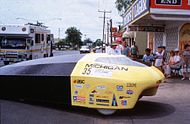Composition and history
Founded in 1989 by Bill Kaliardos, an undergraduate student in Aerospace Engineering and Mechanical Engineering, the University of Michigan Solar Car Team is one of the largest and most successful student projects at the university. The inaugural 1990 team, which formed in 1989, was eventually managed by Susan Fancy, with Professor and Dean Gene Smith serving as the team's Faculty Advisor. Gene Smith was also Advisor for many other U-M Solar Car Teams to follow. The teams have built eleven solar cars and competed in 15 major races. Although it draws heavily on undergraduate students from the College of Engineering, students from any academic discipline or year of study are allowed to join the team. Students have also come from the College of LS&A, the Ross School of Business, and the Stamps School of Art & Design.
In 1990, the team's first car, Sunrunner, finished in first place in the inaugural GM Sunrayce USA, and third place overall (first place in Student category) in the 1990 World Solar Challenge in Australia. Core team members of the 1990 team included Susan Fancy, Paula Finnegan, David Noles, Chetan Maini (Maini went on to become the founder of Reva which is one of the major electric car companies in India), David Bell, Jef Pavlat, Andy Swiecki, Chris Gregory, and many more.
The second generation team built its car, Maize & Blue, and competed in Sunrayce 93 (the predecessor to the North American Solar Challenge) finishing in first place in the national race, and 11th in the World Solar Challenge.
After 1993's races, all projects have run on a 2-year cycle. During those two years, the team is typically anywhere from 50 to 100 students. The vast majority of these students volunteer their time freely, although in the past a small percentage opt to receive credit via the university's Undergraduate Research Opportunities Program (or UROP). A race crew of approximately 20 students is selected to race the vehicle in competition. These students' function is similar to that of a pit crew in professional auto racing.
As of 2016, UM's solar car project has won the North American championship nine times.

The World Solar Challenge (WSC), since 2013 named Bridgestone World Solar Challenge, is an international event for solar powered cars driving 3000 kilometres through the Australian outback.

Nuna is the name of a series of crewed solar powered race cars that have won the World Solar Challenge in Australia seven times: in 2001, 2003, 2005, 2007, 2013, 2015 and 2017. The vehicles are built by students who are part of the "Brunel Solar Team" at the Delft University of Technology in the Netherlands, sponsored by Brunel.

The American Solar Challenge (ASC), previously known as the North American Solar Challenge and Sunrayce, is a solar car race across the United States. In the race, teams from colleges and universities throughout North America design, build, test, and race solar-powered vehicles in a long distance road rally-style event. ASC is a test of teamwork, engineering skill, and endurance that stretches across thousands of miles of public roads.

The University of Calgary Solar Car Team is a multi-disciplinary student-run solar car racing ("raycing") team at the University of Calgary, based in Calgary, Alberta, Canada. It was established to design and build a solar car to compete internationally in the American Solar Challenge (ASC) and the World Solar Challenge (WSC). The team is primarily composed of undergraduate students studying Engineering, Business, Science, Arts and Kinesiology. The mission of the University of Calgary Solar Car Team is to educate the community about sustainable energy and to serve as an interdisciplinary project through which students and faculty from various departments can collaborate in supporting sustainable energy.
Crowder College is a public community college in Neosho, Missouri. It serves the Community College District of Newton and McDonald counties in southwestern Missouri and other outlying areas. The school enrolled 3,864 in 2023.

The University of Minnesota Solar Vehicle Project, or UMNSVP, is a team of undergraduate students from the University of Minnesota that designs and constructs solar-powered cars. In its 31 years, it has established itself as one of the world's top solar racing teams, and the top Cruiser/Multi-Occupant Vehicle team in the Western Hemisphere, with top-two finishes in eighteen of thirty-four events entered.
PrISUm Solar Car is the multidisciplinary student-run solar car racing team from Iowa State University that designs and builds solar powered vehicles to compete in the American Solar Challenge (ASC). The club was founded in 1989 by a group of engineering honor students from Tau Beta Pi and was simply known as the ISU Solar Car Project. In 1990, the team adopted the name of its first car, PrISUm.

The 1993 Maize & Blue solar car was built by the University of Michigan Solar Car Team during the period from 1990 to 1993.

A solar car is a solar vehicle for use on public roads or race tracks. Solar vehicles are electric vehicles that use self-contained solar cells to provide full or partial power to the vehicle via sunlight. Solar vehicles typically contain a rechargeable battery to help regulate and store the energy from the solar cells and from regenerative braking. Some solar cars can be plugged into external power sources to supplement the power of sunlight used to charge their battery.
Solar car racing refers to competitive races of electric vehicles which are powered by solar energy obtained from solar panels on the surface of the car. The first solar car race was the Tour de Sol in 1985 which led to several similar races in Europe, US and Australia. Such challenges are often entered by universities to develop their students' engineering and technological skills, but many business corporations have entered competitions in the past. A small number of high school teams participate in solar car races designed exclusively for high school students.
The Cal State LA Solar Car Team was a group of engineering students at California State University, Los Angeles that developed the Solar Eagle series of solar cars that competed in solar car races in the United States and Australia.

The Midnight Sun Solar Rayce Car Team is a Canadian solar car race team affiliated with the University of Waterloo of Waterloo, Ontario. Founded in 1988, the Midnight Sun team is a student-run organization which designs and builds a solar vehicle every two to three years to compete in two solar challenges; the World Solar Challenge, held in Australia, and the American Solar Challenge, held in the United States.
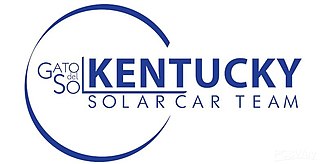
The University of Kentucky Solar Car Team is an independent, student-led project that operates as part of the University of Kentucky College of Engineering. The team's primary goal is to compete in the American Solar Challenge and the Formula Sun Grand Prix over the summer, but they also perform outreach events in which they display and discuss their car with nonmembers.
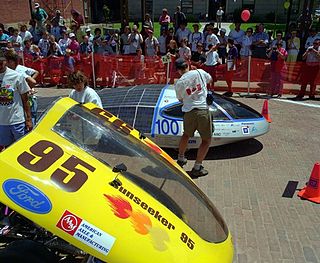
The Sunseeker Solar Car Project, Sunseeker for short, is Western Michigan University's solar car team. Each vehicle is designed, built, maintained, and raced by students. Sunseeker has competed in all of the American Solar Challenge events, going back to 1990.
In July 1990, 32 teams of some of North America's brightest college students took to the road in solar-powered vehicles they had built during the previous year and a half. The GM Sunrayce USA route covered more than 1,800 miles, from Florida to Michigan. Three of the top finishers won a trip to Australia in November to compete in the 1990 World Solar Challenge.

Blue Sky Solar Racing is a student-run team at the University of Toronto that designs and constructs solar powered vehicles to race in international competitions.
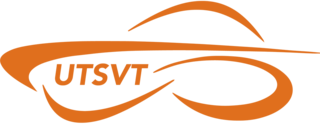
The University of Texas Solar Vehicles Team (UTSVT) is a student-driven effort to design, build, test, and race solar vehicles for the purpose of reinforcing skills learned in the classroom, raising awareness of solar power, and bringing solar power closer to practicality. To accomplish this task, a multidisciplinary group of students from various disciplines in the Cockrell School of Engineering, and from other schools across the University of Texas, such as the College of Liberal Arts and the College of Natural Sciences come together to design and construct the most efficient vehicle as possible.

The Formula Sun Grand Prix (FSGP) is an annual solar-car race that takes place on closed-loop race tracks. In the race, teams from colleges and universities throughout North America design, build, test, and race solar-powered vehicles.

ANU Solar Racing is the Australian National University's student-led solar car racing team. The team is built to innovate, bringing together a highly range of backgrounds ranging from engineering and science through to commerce and law. The team consists of all undergraduate students, and is split into an Executive Branch, Technical Branch, Operational Branch, and Business Branch. The team competes in the biennial World Solar Challenge from Darwin to Adelaide, covering 3,022 km of road. The next event for ANU Solar Racing event is the 2023 Bridgestone World Solar Challenge.
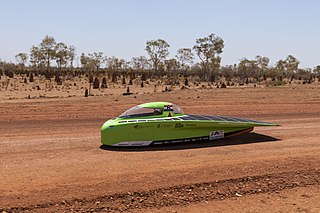
Top Dutch Solar Racing (TDSR) is a student solar racing team from Groningen, the Netherlands. It was founded in February 2017 and participated in the challenger class of the Bridgestone World Solar Challenge (BWSC) for the first time in 2019. In contrast to the cruiser class, cars competing in the challenger class are designed to reach the finishing line of the BWSC as fast and efficiently as possible. Due to the cancelation of the 2021 edition of the BWSC, Top Dutch Solar Racing plans on participating again in the 2023 edition.


